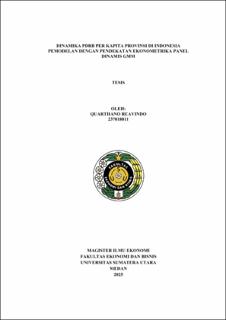Dinamika PDRB Per Kapita Provinsi Di Indonesia Pemodelan Dengan Pendekatan Ekonometrika Panel Dinamis GMM
Dynamics Of GRDP Per Capita Of Provinces In Indonesia Modeling With GMM Dynamic Panel Econometric Approach

Date
2025Author
Reavindo, Quarthano
Advisor(s)
Pratomo, Wahyu Ario
Irsad
Metadata
Show full item recordAbstract
This research aims to analyze determinants factors of economic growth among provinces in Indonesia during the period of2016-2022 using a dynamic panel data approach. Gross Regional Domestic Product (GRDP) per capita serves as the main indicator of regional economic performance. The independent variables include road length, number of schools, average length of schooling, life expectancy, labor force participation rate (TPAK), skilled labor, and the Information and Communication Technology Development Index (ICT-DI). The estimation results show that human capital variables, especially average length of schooling and life expectancy, have a positive and significant effect on increasing GRDP per capita. The TPAK variable also shows a significant contribution in driving economic growth. On the other hand, physical infrastructure variables such as road length and number of schools have a significant negative effect, indicating that infrastructure development is not effective enough if it is not accompanied by an increase in quality and utilization. The skilled labor and ICT-DI variables do not show a statistically significant effect, indicating that there is still a gap between technological capacity and workforce skills. In addition, this research finds a process of economic convergence among provinces, with a convergence speed of 0.5094, which means around 50% of the gap in GRDP per capita can be corrected within one year. This finding emphasizes the importance of a development strategy that balances physical investment and strengthens the quality of human resources and digital transformation to support sustainable and inclusive regional economic growth.
Collections
- Master Theses [532]
